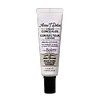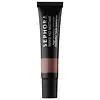theBalm Cosmetics Anne T. Dotes Liquid Concealer Versus Sephora Collection Make No Mistake Full Coverage Concealer
What's inside
What's inside
 Key Ingredients
Key Ingredients

 Benefits
Benefits

 Concerns
Concerns

 Ingredients Side-by-side
Ingredients Side-by-side

Water
Skin ConditioningCoconut Alkanes
EmollientGlycerin
HumectantPropanediol
SolventTriethylhexanoin
MaskingTrimethylsiloxysilicate
EmollientPolyglyceryl-6 Polyricinoleate
EmulsifyingCaprylic/Capric Triglyceride
MaskingPolyglyceryl-6 Polyhydroxystearate
EmulsifyingSimmondsia Chinensis Seed Oil
EmollientLecithin
EmollientPolyhydroxystearic Acid
EmulsifyingBoron Nitride
AbsorbentGlyceryl Caprylate
EmollientMagnesium Sulfate
Stearalkonium Hectorite
Gel FormingTriethoxycaprylylsilane
Propylene Carbonate
SolventCoco-Caprylate/Caprate
EmollientDehydroacetic Acid
PreservativeAscorbyl Palmitate
AntioxidantXanthan Gum
EmulsifyingGlyceryl Undecylenate
EmollientHelianthus Annuus Seed Oil
EmollientTremella Fuciformis Extract
HumectantGluconolactone
Skin ConditioningTocopherol
AntioxidantLauroyl Lysine
Skin ConditioningBeta-Sitosterol
Emulsion StabilisingSodium Hyaluronate
HumectantSqualane
EmollientPhenoxyethanol
PreservativeSodium Benzoate
MaskingCalcium Gluconate
HumectantMica
Cosmetic ColorantCI 77891
Cosmetic ColorantIron Oxides
Water, Coconut Alkanes, Glycerin, Propanediol, Triethylhexanoin, Trimethylsiloxysilicate, Polyglyceryl-6 Polyricinoleate, Caprylic/Capric Triglyceride, Polyglyceryl-6 Polyhydroxystearate, Simmondsia Chinensis Seed Oil, Lecithin, Polyhydroxystearic Acid, Boron Nitride, Glyceryl Caprylate, Magnesium Sulfate, Stearalkonium Hectorite, Triethoxycaprylylsilane, Propylene Carbonate, Coco-Caprylate/Caprate, Dehydroacetic Acid, Ascorbyl Palmitate, Xanthan Gum, Glyceryl Undecylenate, Helianthus Annuus Seed Oil, Tremella Fuciformis Extract, Gluconolactone, Tocopherol, Lauroyl Lysine, Beta-Sitosterol, Sodium Hyaluronate, Squalane, Phenoxyethanol, Sodium Benzoate, Calcium Gluconate, Mica, CI 77891, Iron Oxides
Hydrogenated Polyisobutene
EmollientSilica Silylate
EmollientCaprylic/Capric Triglyceride
MaskingBis-Diglyceryl Polyacyladipate-2
EmollientLauroyl Lysine
Skin ConditioningBoron Nitride
AbsorbentIsotridecyl Isononanoate
EmollientSorbitan Sesquiisostearate
EmulsifyingPolyhydroxystearic Acid
EmulsifyingTriethylhexanoin
MaskingStearalkonium Hectorite
Gel FormingSorbitan Sesquioleate
EmulsifyingHelianthus Annuus Seed Oil
EmollientGlyceryl Behenate
EmollientPolyglyceryl-6 Octastearate
EmulsifyingPropylene Carbonate
SolventAluminum Hydroxide
EmollientCurcuma Longa Leaf Extract
Skin ConditioningCaprylyl Glycol
EmollientTocopherol
AntioxidantCI 77891
Cosmetic ColorantCI 77491
Cosmetic ColorantHydrogenated Polyisobutene, Silica Silylate, Caprylic/Capric Triglyceride, Bis-Diglyceryl Polyacyladipate-2, Lauroyl Lysine, Boron Nitride, Isotridecyl Isononanoate, Sorbitan Sesquiisostearate, Polyhydroxystearic Acid, Triethylhexanoin, Stearalkonium Hectorite, Sorbitan Sesquioleate, Helianthus Annuus Seed Oil, Glyceryl Behenate, Polyglyceryl-6 Octastearate, Propylene Carbonate, Aluminum Hydroxide, Curcuma Longa Leaf Extract, Caprylyl Glycol, Tocopherol, CI 77891, CI 77491
Ingredients Explained
These ingredients are found in both products.
Ingredients higher up in an ingredient list are typically present in a larger amount.
Boron Nitride is compound consisting of boron and nitrogen. It is used to absorb oil and modify adherence/ slip in products.
This means it is often used in makeup products to help them last longer.
This ingredient is an emollient, solvent, and texture enhancer. It is considered a skin-softener by helping the skin prevent moisture loss.
It helps thicken a product's formula and makes it easier to spread by dissolving clumping compounds.
Caprylic Triglyceride is made by combining glycerin with coconut oil, forming a clear liquid.
While there is an assumption Caprylic Triglyceride can clog pores due to it being derived from coconut oil, there is no research supporting this.
Learn more about Caprylic/Capric TriglycerideCi 77891 is a white pigment from Titanium dioxide. It is naturally found in minerals such as rutile and ilmenite.
It's main function is to add a white color to cosmetics. It can also be mixed with other colors to create different shades.
Ci 77891 is commonly found in sunscreens due to its ability to block UV rays.
Learn more about CI 77891Helianthus Annuus Seed Oil is the oil derived from the seeds of a Sunflower. Sunflower seed oil is non-fragrant. It is an emollient, meaning it helps to soften the skin.
Sunflower seed oil contains many fatty acids. The fatty acids found in sunflower seeds include (from highest amount to least): linoleic acid, myristic acid, palmitic acid, stearic acid, arachidic acid, oleic acid, and linolenic acid.
These fatty acids help the skin create ceramides. Ceramides play a role in repairing the skin barrier.
Helianthus Annuus Seed Oil helps moisturize the skin. This in turn helps the skin look more rejuvenated and smoother.
Sunflowers are rich in vitamin E.
Historians believe Indigenous cultures of North America domesticated sunflowers before corn. Thus they relied on sunflower oil for a variety of uses. One such use is moisturizing skin and hair.
Sunflower seed oil may not be fungal acne safe. We recommend speaking with a professional if you have any concerns.
Learn more about Helianthus Annuus Seed OilThis ingredient comes from a fatty acid (lauric acid) and amino acid (lysine). It is used to add a silky feel to cosmetics.
According to a manufacturer, its fatty acid base leaves a silky feeling on the skin. It also has emollient properties because of this. Emollients help soften skin by preventing water from evaporating.
Lauroyl lysine is barely soluble in water.
Learn more about Lauroyl LysinePolyhydroxystearic Acid is a soft wax made from castor oil.
It is is a texture thickener, emulsifier, and film-former. Emulsifiers prevent ingredients from separating, such as oils and waters.
Polyhydroxystearic Acid may not be fungal acne safe.
Learn more about Polyhydroxystearic AcidThis ingredient is a solvent. It helps dissolve active ingredients and alter the texture of products.
Propylene Carbonate is commonly used in makeup and with clay, such as montmorillonite or bentonite.
Studies show this ingredient to be safe for cosmetics. When it is undiluted, it can cause skin irritation. (It is always diluted in skincare and makeup). This ingredient is water-soluble.
Propylene Carbonate is created from propylene glycol and carbonic acid.
Learn more about Propylene CarbonateStearalkonium Hectorite is a clay-derived ingredient used to thicken a product and help create a gel-like texture.
Tocopherol (also known as Vitamin E) is a common antioxidant used to help protect the skin from free-radicals and strengthen the skin barrier. It's also fat soluble - this means our skin is great at absorbing it.
Vitamin E also helps keep your natural skin lipids healthy. Your lipid skin barrier naturally consists of lipids, ceramides, and fatty acids. Vitamin E offers extra protection for your skin’s lipid barrier, keeping your skin healthy and nourished.
Another benefit is a bit of UV protection. Vitamin E helps reduce the damage caused by UVB rays. (It should not replace your sunscreen). Combining it with Vitamin C can decrease sunburned cells and hyperpigmentation after UV exposure.
You might have noticed Vitamin E + C often paired together. This is because it is great at stabilizing Vitamin C. Using the two together helps increase the effectiveness of both ingredients.
There are often claims that Vitamin E can reduce/prevent scarring, but these claims haven't been confirmed by scientific research.
Learn more about TocopherolTriethylhexanoin is created from glycerin and 2-ethylhexanoic acid. It is a solvent and emollient.
As a solvent, Triethylhexanoin helps dissolve ingredients to stable bases or help evenly distribute ingredients throughout the product.
It is also an emollient and helps condition the skin.
Learn more about Triethylhexanoin